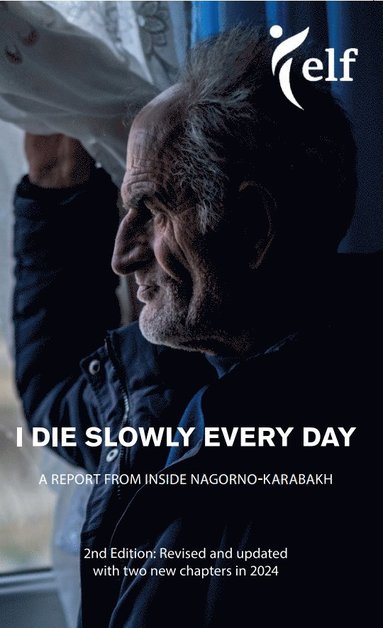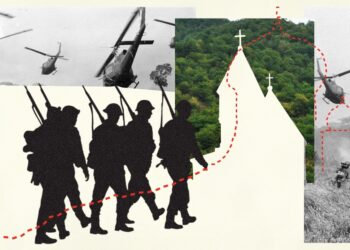

I DIE SLOWLY EVERY DAY
by Rasmus Canbäck
SILC Förlag
Release date: March 31, 2025
Listen to the article.
In his book “I Die Slowly Every Day”, Swedish journalist Rasmus Canbäck offers one of the last independent testimonies from inside Armenian-populated Nagorno-Karabakh before its ethnic cleansing. What begins as a straightforward journalistic pursuit transforms into a profound confrontation with propaganda, silence and the politics of erasure. This review explores the narrative scope, emotional weight, and political urgency of Canbäck’s work.
Canbäck was the last foreign journalist to enter Artsakh before it was blockaded and emptied of its Armenian population. From the outset, the stakes are made clear: a journalist navigating the tightly controlled landscape of Azerbaijani propaganda and control. He opens with a pivotal moment—when his editor receives a message that the Azerbaijani ambassador to Sweden had written in to dispute one of Canbäck’s articles. It’s not an isolated incident, but rather part of a systematic campaign of intimidation.
“The fact that a government representative has taken the time to write to me tells me that I am no longer just observing the war. I am in the middle of it.”
This quote sets the tone for the entire book. Though Canbäck aims to understand and report on the conflict from both Armenian and Azerbaijani perspectives, he quickly encounters bureaucratic obstacles and ideological restrictions imposed by the Azerbaijani state.
He doesn’t dramatize this. Instead, he illustrates how dictatorships treat nuance as a threat, drawing tight borders around speech, access and narrative control. It’s a subtle but damning portrayal of the conditions under which stories like Artsakh’s must now be told.
This initial confrontation directly connects to the global silence that surrounded the 2020 war, the 10-month blockade, and the ethnic cleansing of Artsakh. It also reveals the deeper problem of fatigue in international media—their reluctance to cover unresolved conflicts, especially when access is restricted and narratives carry political risk. In this vacuum, stories simply disappear.
After the 2020 war, access to Artsakh was tightly restricted by Russian peacekeepers, who assumed control of the Lachin Corridor, the only lifeline between Armenia and Nagorno-Karabakh. While most foreign journalists were denied entry, Canbäck gained access to the region in March 2021, accompanied by his fixer Nvard Melkonyan and photographer Areg Balayan. As he journeys into this war-torn landscape, he weaves a concise and accessible history of the conflict, from its pre-Soviet past to the 44-day war.
The heart of the book lies not in the political overviews but in intimate human stories. Canbäck moves seamlessly from political analysis to everyday life in Stepanakert and the villages at the peripheries of post-war, fragile Artsakh. Old women prepare jingyalov hats at market stalls. Children dart between bomb-scarred buildings. A young football league practices in a bomb-cratered field. Nurses recall the grim chaos of wartime hospital wards. An old man sifts through rubble for tea and sweets to serve an unexpected guest.
These moments, small and mundane, become a quiet act of resistance. The hospitality, the tea, the last pomegranate—it’s life that happens between the bombings. This struggle for normalcy faces new threats at every turn, culminating in Azerbaijan’s full blockade and the ethnic cleansing of the region.
Throughout, Canbäck is careful to reveal the scaffolding behind these personal stories: the political logistics, foreign policy dynamics, and international silences that allow these conditions to persist. He addresses war crimes not in the abstract, but through context and detail. The imbalance in reporting is stark, particularly in Western media outlets that strive to appear neutral while glossing over the reality of authoritarian aggression.
“Bothsideism is an ever-present concept in the journalistic discourse on the Nagorno-Karabakh conflict… The best journalism is found in the Caucasus, often in local English-language newspapers. Regrettably, it does not lie at the heart of international reporting.”
Canbäck avoids this tired framing altogether. His coverage achieves true balance through principled, precise and human-centered reporting. Even when covering diplomatic processes, he keeps the stakes grounded—these aren’t abstract negotiations but decisions that affect real lives.
The most striking quality of the book is how intimately Canbäck writes about Artsakh. Though a foreign journalist, he carries an extraordinary familiarity with the intricacies and quiet habits of life in Nagorno-Karabakh––almost as if he’s lived there for years, speaks their local dialect fluently, and understands all their inside jokes. He holds their stories with both urgency and composed patience, never overlooking the small, mundane details that locals know are essential but outsiders often dismiss. He gives their words weight, as if he understands the full shape of their lives and the psychology formed by years of living in the colorful, sunny streets of Stepanakert and foggy neighborhoods of Shushi under a looming threat nearby. In these moments, he’s not an outsider at all, but someone who truly sees and understands the people of Artsakh.
There are moments when Canbäck challenges the Artsakhtsis he meets. Some things perplex him, and he asks difficult questions, creating moments of discomfort. Through these exchanges, important context and dialogues emerge. We witness the rawness of disagreement and honest discussion, a refreshing departure from typical stories about war-torn lives, where empathy often remains passive and complexity gets smoothed away.
Even when he disagrees, there’s no undertone of arrogance or self-righteousness—he questions himself too. He acknowledges the vast disparity between lives lived across continents, particularly between the people of Artsakh and the rest of the world. Though aware that much remains invisible to him, he keeps digging, relentlessly yet humbly, trying to understand what defies simple explanation.
“Questions like this are awkward to raise after the war… What does it do to a people to spend the past 30 years in constant preparation for the next attack?”
Some accounts of war and tragedy read like observations—kept at a distance, clinical, safe. Others are built entirely on listening and bearing witness, empathetic, yet still detached. Then there is Canbäck’s approach: he becomes almost an active participant in the lives he writes about. Rather than hovering on the sidelines, he steps in, accepts their tea and coffee, stays longer than expected, asks uncomfortable questions. He offers something in return: conversation, honesty, even moments of irritation. He engages, challenges, jokes and provokes. Rather than playing the polite outsider, he insists on being something messier: a curious neighbor, an inconvenient guest, a friend who hasn’t earned the title but desperately wants to understand.
His approach makes his presence felt in every story, not as a distant narrator, but as someone trying, earnestly, if sometimes clumsily, to share the same ground and wavelength with his subjects. His giddy, almost childlike curiosity shines through when one of his interviewees points out, “You eat like an Armenian,” and Canbäck replies, “I learned to do it in Artsakh.”
The diverse voices in the book challenge the oversimplified narratives often applied to Artsakh and its people. They are not a single, unified voice or a monolithic, monochrome entity speaking in perfect harmony. Instead, they are a tapestry: messy, contradictory, deeply human, like a carpet where the back weave holds the colorful ornaments together, grounded in shared history and place. These are people with a wide range of opinions, temperaments, lives and approaches, too often reduced into a single narrative of resistance. Such simplification, even with the best of intentions, does them a disservice.
When he writes about Azerbaijan’s propaganda campaign, especially during and after the blockade, the tone shifts markedly. The flood of disinformation, absurd and overwhelming, becomes a secondary assault: a war on memory itself. Canbäck documents this with clarity and restraint.
The most harrowing section describes the exodus: thousands of cars crawling toward Goris, a journey that should have taken hours stretching into days. In overcrowded hospital wards, wounded and starving children receive treatment. It is a moment of collapse, and Canbäck bears witnesses.
In the epilogue, he steps back to reflect on the broader implications. The world’s indifference to Artsakh, he suggests, represents more than moral failure; it signals something deeper, a fractured world order and an eroded standard of care.
“I Die Slowly Every Day” is more than a mere record of events. It represents a reimagining of journalism, exploring presence, truth-telling in an age of erasure, and the art of being an attentive listener and faithful storyteller. This work is essential reading not only for those who care about Artsakh, but also for anyone invested in the future of journalism and the untold stories that still need telling.
Spotlight Artsakh
Humanitarian Aid to Artsakh Armenians: Who Stepped Up?
Following the 2023 ethnic cleansing of Nagorno-Karabakh Armenians, USAID pledged millions of dollars in humanitarian assistance. As the U.S. significantly cuts aid, Hranoush Dermoyan examines international contributions and the Armenian government’s relief efforts to address the crisis.
Read moreAppropriation of Armenian Cultural Heritage of Artsakh
The 2020 war and 2023 military operations in Artsakh have left Armenian cultural heritage vulnerable to destruction and appropriation. Azerbaijan's reclassification of Armenian sites aims to erase Armenian identity, falsify history, and legitimize territorial claims through cultural expropriation.
Read moreMemories From the Museums of Artsakh
What museum artifacts and historical-cultural treasures remain in Artsakh? Have they been preserved, or have they been vandalized? Are there efforts to transfer them to Armenia? Lilit Avagyan provides insight.
Read moreDestruction of Armenian Cultural Heritage of Artsakh
Azerbaijan’s systematic destruction of Artsakh's cultural heritage not only erases the unique collective identity of its people but also deals a significant blow to the entire world, destabilizing present and future prospects for peace and security in the South Caucasus.
Read moreSo That They Don’t Forget
For the people of Artsakh, the year since their displacement has been marked by the emotional turmoil and darkness of loss. Photojournalist Ani Gevorgyan documents their ongoing struggle to cope with the grief while trying to provide for their families and rebuild their lives.
Read more





